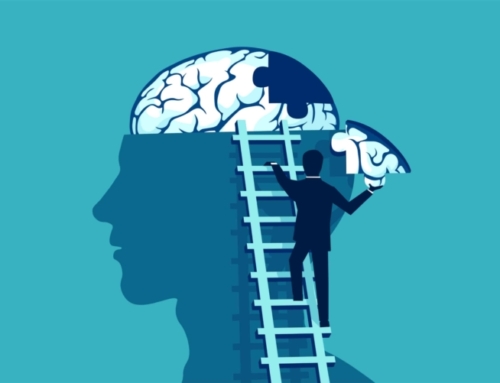Today I discuss ways of viewing the content of our minds in a way that allows greater stress tolerance and, perhaps, a greater sense of freedom and happiness.
Cognitive diffusion (or distancing) is one of the central interventions in both Dialectical Behavior Therapy (DBT) and Acceptance and Commitment Therapy (ACT). Drs. Marsha Linehan and Steven Hayes, developers of these therapies, were trained as behaviorists and practicing Buddhists. (They also collaborated on research studies in the 1980s before taking individual paths.) It’s this background that led to their view of human nature, psychopathology, and psychotherapy.
In cognitive diffusion, the goal is not to try to change the content of one’s thoughts (as is done in classic Cognitive Therapy) through the activity of challenging and replacing problematic thoughts, but rather to develop a different perspective on the nature of one’s thought process. Dr. Hayes writes:
“One purpose of cognitive diffusion is to help people become more aware, in an ongoing manner, of this ubiquitous process of structuring the world through thought, so that might relate to thinking and the world in a more flexible responsive manner even without changing the form or frequency of specific thoughts.”
The goal is to develop a sense of distance and independence from one’s ongoing thinking and feeling that can make a person feel like they are a victim of their emotions and at the mercy of their thoughts and beliefs. These thoughts and emotions are themselves triggered by internal stimuli (e.g., bodily sensations) and external stimuli (e.g., someone’s statement or emotional reaction to you). Thus, it is conceptualized that suffering and a sense of lack of agency derive from the nature of our relationship with the contents of our minds. The problem is not with our thoughts and emotions per se, but rather from our too close alignment (or fusion) with them. Cognitive diffusion “aims at undermining the excessive literality of thinking itself,” according to Dr. Hayes.
Imagine how you would feel if you viewed all the thoughts you’re having – about aspects of yourself, others, the world, the past, or the future – not necessarily as truths or valued beliefs but rather as hypotheses that may be right or wrong, or beneficial or not beneficial to reaching your life goals. You can remind yourself that your mind is always thinking; internal language-based cognating is just what those language networks in the brain are responsible for, and that it is not possible to turn them off, although it is possible to change your perspective about all that thinking.
I will sometimes ask a person to imagine sitting at the Thanksgiving table next to their opinionated grandmother or uncle. Just because this family member is holding forth on their views of the world and politics, does not compel you to treat this person’s ideas as necessarily correct or wise or valuable to you. You accept or reject their particular ideas based on your own experiences and your values. Their thoughts are not a problem for you unless you choose to make them so.
Now, how would you feel if you were able to treat your own thoughts with that same sort of distance, not compelled to agree or disagree with them? What if you were able to evaluate your thoughts based on how well they further your goals and values, and not treat them epistemically infallible?
If you’re able to feel less pushed and pulled by whatever the current thought is that popped into your head, a thought that itself was triggered by some stimulus outside of your control, you will feel a greater sense of freedom, control, agency, and a greater emotional equanimity.
So, how can a person develop cognitive diffusion as a habitual mode of relating to one’s thought content? Here are examples of diffusion exercises, some of which go back thousands of years and some of which were developed since the 1970s:
- Imagine placing your thoughts on leaves floating down a stream.
- Imagine placing your thoughts on clouds that float away.
- Imagine you are a mountain, ancient and grounded, that faces the seasons as they change with all the times of rain and storms, nights and daytimes, and all kinds of weather.
- Imagine you’re observing, self-situated in an expansive, quiet, and safe space, and able to observe your thoughts and emotions with distance, acceptance, and compassion.
- Repeat an anxiety-provoking thought over and over quickly over 30 seconds, so that the meaning of the thought separates from the sound of the words. For example, say very quickly for the full 30 seconds, “I won’t pass my exam. I won’t pass my exam. I won’t pass my exam.” Notice how afterwards, thinking these words does not lead to a strong emotional reaction.
- Imagine adding circus music behind your scary thoughts. Or singing your scary thoughts in a funny voice.
- Imagine the scary “videos” playing in your head are playing on a screen. You reach out and change the color or brightness of the image, or the volume of the sound, as you would on a television or tablet.
- When describing your thoughts to yourself or another person, preface it with, “My mind was thinking …” Or “I am having the thought that …”
Until next time,
Dr. Jack
LanguageBrief
“The Ego … is simply the content of your PSM [Phenomenal Self Model] at this moment (your bodily sensations, your emotional state, your perceptions, memories, acts of will, thoughts). But it can become the Ego only because you are constitutionally unable to realize that all this is just the content of a simulation in your brain. It is not reality itself but an image of reality – and a very special one indeed. The Ego is a transparent mental image: You – the physical person as a whole – look right through it. You do not see it. You see with it.” – Thomas Metzinger, The Ego Tunnel
“Yes, there is an outside world, and yes, there is an objective reality, but in moving through this world, we constantly apply unconscious filter mechanisms, and in doing so, we unknowingly construct our own individual world, which is our “reality tunnel.” – Thomas Metzinger, The Ego Tunnel
The Global Neuronal Workspace (GNW) model’s main postulate is that “Conscious access is global information availability: what we subjectively experience as conscious access is the selection, amplification, and global broadcasting, to many distant areas, of a single piece of information selected for its salience or relevance to current goals…. The GNW model proposes that associative perceptual, motor, attention, memory, and value areas interconnect to form a higher level unified space where information is broadly shared and broadcasted back to lower-level processors.” – Dehaene S et al. The Global Neuronal Workspace Model of Conscious Access: From Neuronal Architectures to Clinical Applications







Leave A Comment